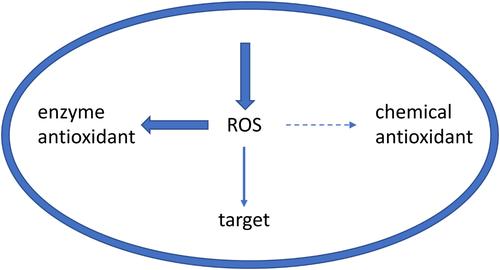当前位置:
X-MOL 学术
›
Mol. Microbiol.
›
论文详情
Our official English website, www.x-mol.net, welcomes your
feedback! (Note: you will need to create a separate account there.)
Antioxidants are ineffective at quenching reactive oxygen species inside bacteria and should not be used to diagnose oxidative stress
Molecular Microbiology ( IF 2.6 ) Pub Date : 2024-06-18 , DOI: 10.1111/mmi.15286 Sergey Korshunov 1 , James A Imlay 1
Molecular Microbiology ( IF 2.6 ) Pub Date : 2024-06-18 , DOI: 10.1111/mmi.15286 Sergey Korshunov 1 , James A Imlay 1
Affiliation

|
A wide variety of stresses have been proposed to exert killing effects upon bacteria by stimulating the intracellular formation of reactive oxygen species (ROS). A key part of the supporting evidence has often been the ability of antioxidant compounds to protect the cells. In this study, some of the most-used antioxidants—thiourea, glutathione, N-acetylcysteine, and ascorbate—have been examined. Their ability to quench superoxide and hydrogen peroxide was verified in vitro, but the rate constants were orders of magnitude too slow for them to have an impact upon superoxide and peroxide concentrations in vivo, where these species are already scavenged by highly active enzymes. Indeed, the antioxidants were unable to protect the growth and ROS-sensitive enzymes of E. coli strains experiencing authentic oxidative stress. Similar logic posits that antioxidants cannot substantially quench hydroxyl radicals inside cells, which contain abundant biomolecules that react with them at diffusion-limited rates. Indeed, antioxidants were able to protect cells from DNA damage only if they were applied at concentrations that slow metabolism and growth. This protective effect was apparent even under anoxic conditions, when ROS could not possibly be involved, and it was replicated when growth was similarly slowed by other means. Experimenters should discard the use of antioxidants as a way of detecting intracellular oxidative stress and should revisit conclusions that have been based upon such experiments. The notable exception is that these compounds can effectively degrade hydrogen peroxide from environmental sources before it enters cells.
中文翻译:

抗氧化剂无法有效抑制细菌内的活性氧,因此不应用于诊断氧化应激
人们提出多种应激通过刺激细胞内活性氧(ROS)的形成来对细菌发挥杀伤作用。支持证据的一个关键部分通常是抗氧化剂化合物保护细胞的能力。在这项研究中,我们对一些最常用的抗氧化剂——硫脲、谷胱甘肽、N-乙酰半胱氨酸和抗坏血酸进行了检查。它们淬灭超氧化物和过氧化氢的能力在体外得到了验证,但速率常数太慢了几个数量级,无法对体内超氧化物和过氧化物浓度产生影响,因为这些物质已经被高活性酶清除。事实上,抗氧化剂无法保护经历真正氧化应激的大肠杆菌菌株的生长和 ROS 敏感酶。类似的逻辑认为,抗氧化剂不能基本上消除细胞内的羟基自由基,细胞内含有丰富的生物分子,它们以有限的扩散速率与羟基自由基发生反应。事实上,只有在减缓新陈代谢和生长的浓度下使用抗氧化剂才能保护细胞免受 DNA 损伤。即使在缺氧条件下(ROS 不可能参与其中),这种保护作用也很明显,并且当通过其他方式类似地减缓生长时,这种保护作用也会被复制。实验者应放弃使用抗氧化剂作为检测细胞内氧化应激的方法,并应重新审视基于此类实验的结论。值得注意的例外是,这些化合物可以在环境来源的过氧化氢进入细胞之前有效地将其降解。
更新日期:2024-06-18
中文翻译:

抗氧化剂无法有效抑制细菌内的活性氧,因此不应用于诊断氧化应激
人们提出多种应激通过刺激细胞内活性氧(ROS)的形成来对细菌发挥杀伤作用。支持证据的一个关键部分通常是抗氧化剂化合物保护细胞的能力。在这项研究中,我们对一些最常用的抗氧化剂——硫脲、谷胱甘肽、N-乙酰半胱氨酸和抗坏血酸进行了检查。它们淬灭超氧化物和过氧化氢的能力在体外得到了验证,但速率常数太慢了几个数量级,无法对体内超氧化物和过氧化物浓度产生影响,因为这些物质已经被高活性酶清除。事实上,抗氧化剂无法保护经历真正氧化应激的大肠杆菌菌株的生长和 ROS 敏感酶。类似的逻辑认为,抗氧化剂不能基本上消除细胞内的羟基自由基,细胞内含有丰富的生物分子,它们以有限的扩散速率与羟基自由基发生反应。事实上,只有在减缓新陈代谢和生长的浓度下使用抗氧化剂才能保护细胞免受 DNA 损伤。即使在缺氧条件下(ROS 不可能参与其中),这种保护作用也很明显,并且当通过其他方式类似地减缓生长时,这种保护作用也会被复制。实验者应放弃使用抗氧化剂作为检测细胞内氧化应激的方法,并应重新审视基于此类实验的结论。值得注意的例外是,这些化合物可以在环境来源的过氧化氢进入细胞之前有效地将其降解。






























 京公网安备 11010802027423号
京公网安备 11010802027423号